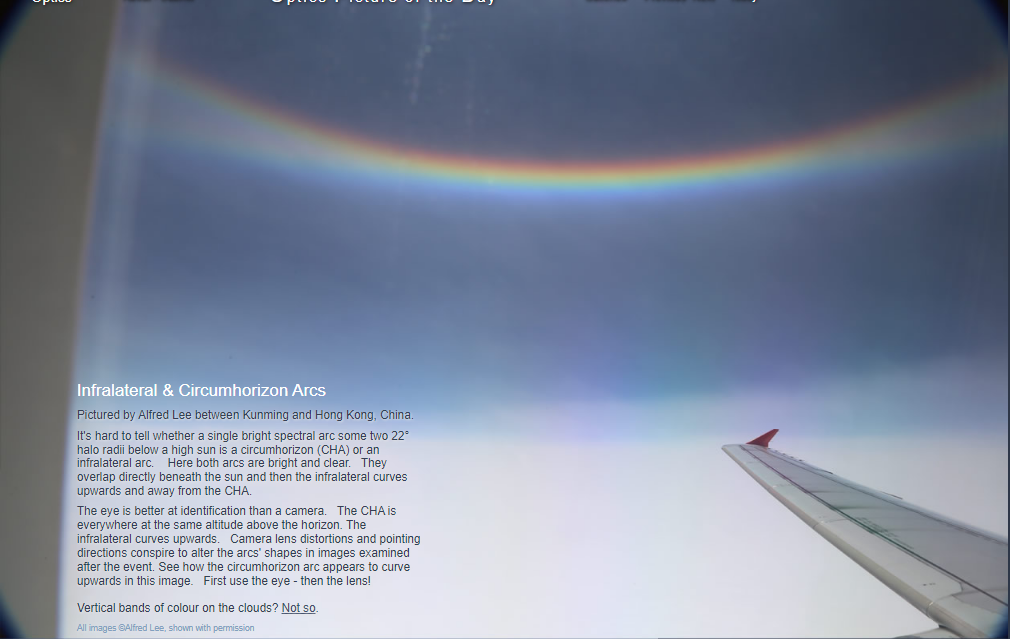Infralateral & Circumhorizon Arcs from the Air - OPOD
Infralateral & Circumhorizon Arcs from the Air: A Spectacular Atmospheric Phenomenon
Have you ever witnessed a captivating display of atmospheric optics while looking up at the sky? One such phenomenon is the occurrence of infralateral and circumhorizon arcs. These mesmerizing arcs, captured by Alfred Lee between Kunming and Hong Kong, China, leave us in awe of the wonders of our atmosphere.
When observing a single bright spectral arc positioned approximately 22° below a high sun, it can be challenging to determine whether it is a circumhorizon arc (CHA) or an infralateral arc. However, in the stunning images captured by Lee, both arcs are distinctly visible. They overlap directly beneath the sun, and then the infralateral arc curves upwards and away from the CHA, creating a captivating visual spectacle.
While photographs can provide us with a glimpse of these arcs, our eyes are better equipped for identification than cameras. The CHA appears at the same altitude above the horizon throughout its entire span, while the infralateral arc curves upwards. It is important to note that camera lens distortions and pointing directions can alter the shapes of these arcs in images when examined after the event. Therefore, it is always advisable to trust our own eyes first and then rely on the lens to capture the magic.
But what exactly causes these enchanting arcs to form in our atmosphere? Let's delve into the science behind these optical wonders:
The Circumhorizon Arc (CHA)
The circumhorizon arc, often abbreviated as CHA, is an optical phenomenon that occurs when sunlight passes through ice crystals in cirrus clouds. These high-altitude clouds are composed of tiny hexagonal ice crystals that act as prisms, refracting sunlight and creating a stunning display of colors. The CHA appears as a vivid band of colors parallel to the horizon, stretching horizontally across the sky.
To witness a circumhorizon arc, specific conditions must be met. Firstly, the sun must be high in the sky, typically at an angle greater than 58° above the horizon. Secondly, cirrus clouds must be present, and their ice crystals must be oriented in such a way that sunlight enters one face of the crystal and exits through another, resulting in the refraction and dispersion of light.
The Infralateral Arc
The infralateral arc is another atmospheric optical phenomenon that can be observed alongside the CHA. It appears as a secondary arc positioned below the circumhorizon arc, approximately 22° below the sun. Unlike the CHA, the infralateral arc curves upwards away from the CHA, adding an extra layer of complexity to the spectacle.
Similar to the CHA, the infralateral arc is formed by the refraction of sunlight through ice crystals in cirrus clouds. However, in this case, the orientation of the ice crystals is different, resulting in a distinct arc that curves away from the CHA. The combination of these two arcs creates a mesmerizing visual display that is a treat for both the eyes and the soul.
Differentiating Between the Arcs
Distinguishing between the circumhorizon arc and the infralateral arc can be challenging, especially when viewing photographs. Camera lens distortions and pointing directions can alter the shapes of these arcs, making it difficult to accurately identify them. However, our eyes are remarkably adept at recognizing these phenomena. By observing the altitude and curvature of the arcs relative to the sun, we can differentiate between them with greater accuracy.
The Beauty of Nature's Illusions
When looking up at the sky, we may occasionally spot vertical bands of color on clouds. However, it is important to note that these bands are not caused by the same phenomenon as the CHA and infralateral arc. While they may appear similar at first glance, these bands are unrelated to the refraction of light through ice crystals. Nature's illusions can sometimes deceive us, but by understanding the science behind these atmospheric phenomena, we can appreciate their true beauty.
In conclusion, witnessing the infralateral and circumhorizon arcs is a truly remarkable experience. These captivating optical phenomena remind us of the intricate and mesmerizing nature of our atmosphere. By understanding the science behind these arcs, we can appreciate the awe-inspiring beauty that surrounds us in the sky above. So, next time you find yourself gazing up at the heavens, keep an eye out for these enchanting arcs and let yourself be transported into a world of atmospheric wonder.

Infralateral & Circumhorizon Arcs
Pictured by Alfred Lee between Kunming and Hong Kong, China.
It's hard to tell whether a single bright spectral arc some two 22° halo radii below a high sun is a circumhorizon (CHA) or an infralateral arc. Here both arcs are bright and clear. They overlap directly beneath the sun and then the infralateral curves upwards and away from the CHA.
The eye is better at identification than a camera. The CHA is everywhere at the same altitude above the horizon. The infralateral curves upwards. Camera lens distortions and pointing directions conspire to alter the arcs' shapes in images examined after the event. See how the circumhorizon arc appears to curve upwards in this image. First use the eye - then the lens!
Vertical bands of colour on the clouds? Not so.
All images ©Alfred Lee, shown with permission
Note: this article has been automatically converted from the old site and may not appear as intended. You can find the original article here.
Reference Atmospheric Optics
If you use any of the definitions, information, or data presented on Atmospheric Optics, please copy the link or reference below to properly credit us as the reference source. Thank you!
-
<a href="https://atoptics.co.uk/blog/infralateral-circumhorizon-arcs-from-the-air-opod/">Infralateral & Circumhorizon Arcs from the Air - OPOD</a>
-
"Infralateral & Circumhorizon Arcs from the Air - OPOD". Atmospheric Optics. Accessed on November 21, 2024. https://atoptics.co.uk/blog/infralateral-circumhorizon-arcs-from-the-air-opod/.
-
"Infralateral & Circumhorizon Arcs from the Air - OPOD". Atmospheric Optics, https://atoptics.co.uk/blog/infralateral-circumhorizon-arcs-from-the-air-opod/. Accessed 21 November, 2024
-
Infralateral & Circumhorizon Arcs from the Air - OPOD. Atmospheric Optics. Retrieved from https://atoptics.co.uk/blog/infralateral-circumhorizon-arcs-from-the-air-opod/.